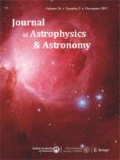Abstract
By calculation of the proton-proton capture cross-section, it is shown that the existence of a bound diproton state would not lead to significant production of diprotons during big bang nucleosynthesis, contrary to popular belief. In typical stellar interiors, the stability of diprotons would lead to a reaction pathway for converting protons to deuterons perhaps ∼1010 times faster than the usual weak capture reaction. This would prevent stars of the familiar hot, dense type from occurring in the universe. However, if diproton stability is achieved by an increase in the low-energy strong coupling, gs, then stars with temperatures and densities sufficiently reduced so as to offset the faster reaction pathway to deuterium will appear to meet elementary stability criteria. The claim that there is a fine-tuned, anthropic upper bound to the strong force which ensures diproton instability therefore appears to be unfounded.
Similar content being viewed by others
References
Agrawal, V., Barr, S. M., Donoghue, J. F., Seckel, D. 1998a, Anthropic considerations in multiple-domain theories and the scale of electroweak symmetry breaking, Phys. Rev. Lett., 80, 1822.
Agrawal, V., Barr, S. M., Donoghue, J. F., Seckel, D. 1998b, The anthropic principle and the mass scale of the standard model, Phys. Rev. D, 57, 5480.
Barrow, J. D., Tipler, F. J. 1986, The Anthropic Cosmological Principle, Oxford University Press.
Blatt, J. M., Weisskopf, V. F. 1952, Theoretical Nuclear Physics, John Wiley.
Carr, B. J., Rees, M. J. 1979, The anthropic principle and the structure of the physical world, Nature, 278, 605.
Carter, B. 1974, Confrontation of cosmological theories with observation: Proc. IAU Symp. 63, 291, (ed.) Longair, M. S., Dordrecht, Reidel.
Davies, P. C. W. 1982, The Accidental Universe, Cambridge University Press.
Davies, P. C. W. 2004, Multiverse cosmological models, Mod. Phys. Lett. A, 19, 727.
Davies, P. C. W. 1972, Time variation of the coupling constants, J. Phys. A, 5, 1296.
Dine, M. 2003, Is there a string theory landscape: some cautionary remarks, Preprint hep-th/0402101.
Dyson, F. J. 1971, Energy in the universe, Sci. Am., 225, 51.
Evans, R. D. 1955, The Atomic Nucleus, McGraw-Hill.
Guth, A. H. 2007, Eternal inflation and its implications, J. Phys. A: Math. Theor., 40, 6811.
Harnik, R., Kribs, G. D., Perez, G. 2006, A universe without weak interactions, Phys. Rev. D, 74, 035006.
Hoffman, R. 2002, Strong and Electromagnetic Reaction Rates 2002, Lawrence Livermore National Laboratory, Nuclear Theory & Modelling Group (http://www-phys.llnl.gov/Research/RRSN/semr/light_reacs.html).
Hogan, C. J. 2000, Why the universe is just so, Rev. Mod. Phys., 72, 1149.
Hogan, C. J. 2006, Nuclear astrophysics of worlds in the string landscape, Phys. Rev. D, 74, 123,514.
Linde, A. 1994, Sci. Am., 271, 32.
Linde, A. 2007a, Sinks in the landscape, Boltzmann brains, and the cosmological constant problem, J. Cosmol. Astropart. Phys., JCAP, 0701, 022.
Linde, A. 2007b, Inflationary cosmology, Preprint hep-th/0705.0164.
Martel, H., Shapiro, P. R., Weinberg, S. 1998, Likely values of the cosmological constant, Astrophys. J., 492, 29.
Rees, M. J. 1999, Just Six Numbers, Weidenfeld & Nicolson, London.
Smith, M. 1988, Caughlan & Fowler 1988 Thermonuclear Reaction Rates, Oak Ridge National Laboratory (http://www.phy.ornl.gov/astrophysics/data/cf88/directory.html).
Susskind, L. 2003, The anthropic landscape of string theory, Preprint hep-th/0302219.
Tegmark, M., Aguirre, A., Rees, M. J., Wilczek, F. 2006, Dimensionless constants, cosmology and other dark matters, Phys. Rev. D, 73, 023505.
Weinberg, S. 2007, Living in the multiverse, In: Universe or Multiverse (ed.) Carr, B., Cambridge University Press, and Preprint hep-th/0511037.
Author information
Authors and Affiliations
Corresponding author
Rights and permissions
About this article
Cite this article
Bradford, R.A.W. The effect of hypothetical diproton stability on the universe. J Astrophys Astron 30, 119–131 (2009). https://doi.org/10.1007/s12036-009-0005-x
Received:
Accepted:
Published:
Issue Date:
DOI: https://doi.org/10.1007/s12036-009-0005-x




